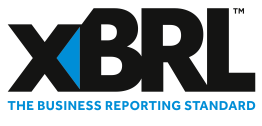XBRL, What Is It?
The acronym XBRL is for Extensible Business Reporting Language. XBRL is a standard, laid out in a series of specifications, that defines the rules and formats on how data about a business is stored in a file.
XBRL Defines a Data Exchange Standard
As the name suggests the format of an XBRL file is XML (Extensible Markup Language), which is a standard for defining standards, see XML in Wikipedia, at W3C or at W3Schools to learn about XML in general.
XBRL allows data about businesses to be exchanged and understood by computer systems without the need for human interpretation. It can be used to reduce paper pushing by automating business data processing. There are three main parts to XBRL, the specification which states the format of XBRL files (formalised in an XML schema), the data files themselves that hold the business data values (as an XML instance file), and the "taxonomies". A taxonomy is a list of classifications which define what the data in the XBRL instance file means according to the business sector. Two systems that are exchanging XBRL data only need to exchange the XBRL XML data file, they will have access to XBRL schemas and relevant taxonomies. The XBRL instance is validated against the XBRL schema and checked against the taxonomies and if they pass those checks the data can be knowingly processed without the need for visual inspection.

XBRL is used globally and is supported by the www.xbrl.org website run by XBRL International, a not for profit global consortium. A more in depth book on XBRL is available as a series of PDF chapters from the Financial Reporting Using XBRL (FRUX) web pages.
Author:Daniel S. Fowler Published: Updated:







